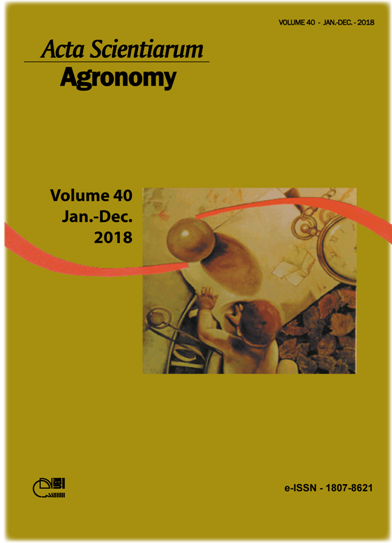<b>Glyphosate efficacy on sourgrass biotypes with suspected resistance collected in GR-crop fields
Resumo
In Brazil, infestations of crop areas with glyphosate-resistant (GR) sourgrass (Digitaria insularis (L.) Fedde) biotypes has risen significantly, increasing crop production costs. Glyphosate efficacy on three biotypes (GO, BA and MT) of sourgrass with suspected resistance was evaluated. A susceptible biotype (MG) was used as the control. The results confirmed that the MG and GO biotypes were susceptible to glyphosate (control > 90%). The MG biotype exhibited growth reduction and mortality by 50% (GR50 and LD50, respectively) with mean glyphosate doses of 243.7 and 431.6 g ae ha-1. The resistance index of the biotypes with suspected resistance ranged from 2.8 to 6.1 in relation to GR50 and between 1.4 to 26.7 in relation to LD50. The glyphosate susceptibility ranking of the sourgrass biotypes was MG < GO < MT < BA. The MT and BA biotypes demonstrated high glyphosate resistance levels, and the GO biotype had a high potential to develop resistance. Farmers should avoid the application of glyphosate overdoses to minimize the selection pressure on weeds.
Downloads
DECLARAÇÃO DE ORIGINALIDADE E DIREITOS AUTORAIS
Declaro que o presente artigo é original, não tendo sido submetido à publicação em qualquer outro periódico nacional ou internacional, quer seja em parte ou em sua totalidade.
Os direitos autorais pertencem exclusivamente aos autores. Os direitos de licenciamento utilizados pelo periódico é a licença Creative Commons Attribution 4.0 (CC BY 4.0): são permitidos o compartilhamento (cópia e distribuição do material em qualqer meio ou formato) e adaptação (remix, transformação e criação de material a partir do conteúdo assim licenciado para quaisquer fins, inclusive comerciais.
Recomenda-se a leitura desse link para maiores informações sobre o tema: fornecimento de créditos e referências de forma correta, entre outros detalhes cruciais para uso adequado do material licenciado.




















































